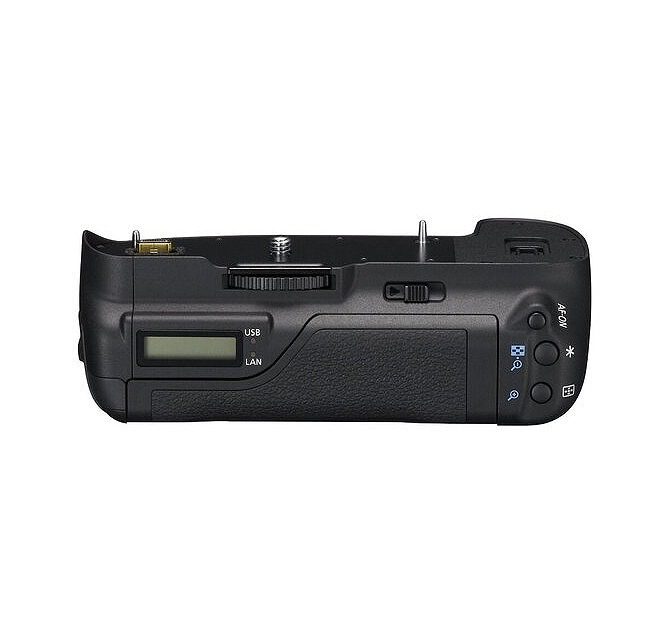Description
Canon WFT-E5
The Canon WFT-E5 Wireless File Transmitter has been launched alongside the Canon EOS 7D to offer the ability to wirelessly transmit images from your camera to a computer, and give enhanced remote capture, media server functionality and linked shooting.
The new WFT-E5 unit takes the Wi-Fi possibilities with the EOS 7D to a new level by offering advantages such as, 802.11a/b and g compatibility, DLNA compliance, an improved HTTP mode called WFT Server and Linked Shooting for remote shutter triggering of up to 10 other EOS 7D cameras.
Who is it for?
Great for sports and news photographers the WFT-E5 unit will allow rapid transfer of images to an access point and out to a picture desk. However, it is not just for the photojournalist community. Studio photographers will enjoy the ability to see previews of their images on a large screen by transmitting JPEGs to their computer. Travel, landscape and wildlife photographers will like the Bluetooth compatibility that allows them to use a Bluetooth connection to a GPS device for geo-tagging, and those photographers who like to experiment with technology to push the boundaries of what is possible will find the linked shooting and advanced WFT Server modes especially appealing.
Key features
- IEEE 802.11a, 802.11b and 802.11g compatibility
- Linked shooting
- DLNA (Digital Living Network Alliance) compatible
- WFT-Server
- EOS Utility Mode
- Bluetooth dongle compatible
- USB host functions
- WiFi Protected Setup (WPS)
- Internal antenna with range of approx. 150m
The transmitter offers high-speed wireless file transfer via three transmission modes for connection to other devices. FTP is used to transfer images to an FTP server. PTP allows two-way communication between the camera and a computer, and HTTP allows a web browser to view images stored on the memory card.
In a first for an EOS camera, the WFT-E5 provides the EOS 7D with a linked shooting ability. This means that a master camera fitted with a WFT-E5 can control up to 10 slave EOS 7D cameras that are also fitted with WFT-E5 units – they can be triggered from the master camera from up to 100m away. In this way, you can capture an image of a subject from several different viewpoints all at the same time.
With the use of the WFT-E5’s built-in WFT Server (formerly HTTP mode), the EOS 7D can be controlled wirelessly over an HTTP connection using a web browser. This means you can see what your camera sees and control the settings and shooting functions through a web browser or even on a device like a smart phone or an iPod touch.
The WFT-E5’s USB port is compatible with a Bluetooth dongle. Using a Bluetooth dongle will allow you to connect with a small Bluetooth GPS device stored in a pocket or in your camera bag to ‘geo-tag’ all images taken on the camera without having to connect any wires between the GPS unit and the camera.
Canon WFT-E5
-
WFT Server
WFT server is an update of the previously named HTTP mode. Where HTTP allowed you to access the images on the camera and download them over an HTPP connection with a web browser, WFT Server allows full control over the camera settings including the use of Live View mode so you can view what the camera sees and adjust focus on a remote computer or smart phone with a web browser that supports javascript.
-
802.11a/b/g
There are several wireless standards for data transmission over wireless networks, by incorporating the 802.11a standard, Canon have ensured that the WFT-E5 is compatible with a wide range of standards. The 802.11a network operates on a frequency of 5GHz which is an un-crowded band and is less affected by radio wave interference making transfer rates more stable. By contrast, 802.11b and 802.11g networks can be affected by interference from Bluetooth devices, cordless telephones, microwave ovens and other devices operating in the 2.4GHz band which can make transfer rates unstable.
-
DLNA
Many consumer electronics devices are compatible with the Digital Living Network Alliance. These include items such as many of the latest generation game consoles as well as some recent televisions and digital photo frames. After establishing a connection between the DLNA device and the WFT-E5, JPEG images stored on the camera can be viewed on the remote device.
-
Linked Shooting
Encapsulating the aim of the EOS 7D to be used by photographers looking to experiment with new techniques and aspects of photography, Linked shooting allows a master camera to trigger up to 10 remote cameras over a range of up to 100m. This allows you to capture still images of a subject from multiple angles or to trigger remote cameras to take images from several locations at once


















